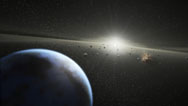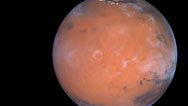Cosmic Ray Danger
- Posted 12.02.10
- NOVA scienceNOW
Cosmic rays are inescapable in space. They can rip right through an astronaut, damaging DNA and possibly causing cancer and memory loss over the long-term. But recent research shows that antioxidants, found in certain berries and fruit, may decrease the effects of this type of radiation.
Transcript
Cosmic Ray Danger
Posted: December 2, 2010
NARRATOR: Produced by exploding stars, high-speed fragments of atoms called cosmic rays are known to tear through astronauts' cells, possibly making them cancerous.
JERRY LINENGER: You go to Mars; you're raising your risk of cancer. Lifelong. There are always innate risks to space travel, and there is no way to get around them. You just do your best to minimize those risks and control them where you can.
NARRATOR: To study how cosmic rays affect our bodies, NASA is making them on Earth, at Brookhaven National Labs. Here, Mary Helen Barcellos-Hoff uses them to bombard human cells. She gets her rays from a giant accelerator that whips subatomic particles to nearly the speed of light.
MARY BARCELLOS-HOFF (Brookhaven National Labs): And indeed when we look at cells that have been exposed to cosmic radiation, we can see each of these dots represent the DNA damage and all the damage is along the particle track. Because the damage is clustered, the damage is more difficult for the cell to deal with.
NARRATOR: And new research into cosmic rays points to another danger that could impact astronauts on long-term missions. They might become like this rat, which cannot find an underwater platform. To Barbara Shukitt-Hale, this rat represents a Mars explorer who might not be coming home.
BARBARA SHUKITT-HALE: Normally, rats have really good spatial memory. So a normal rat would be able to find that platform within five to ten seconds once he's been exposed to this test.
NARRATOR: But even after several trials, this rat just swims round and round until it gets rescued. Why? Because it has received a dose of cosmic rays no greater than a Mars astronaut might get, yet enough to cause a host of problems.
BERNARD RABIN: Problems in learning and memory, and recognition memory, and spatial memory, problems in terms of anxiety levels.
NARRATOR: Problems that make it seem the rats have jumped from youth to senility overnight.
RABIN: It was very surprising to find exposure to cosmic radiation accelerated the aging process. So a mission to Mars may result in accelerated aging, with all the consequences thereof.
NARRATOR: The prospect of befuddled astronauts, their missions disintegrating, can make you despair of humans exploring space—ever. But, fortunately, we have this rat to cheer us up. It finds the platform in seconds, despite having received the same amount of radiation as the first one. And you might not believe what has protected it. These. Foods rich in compounds called antioxidants, which seem to mop up the damaging molecules produced by both aging and cosmic rays. Could berries be our key to the universe? Science has come up with strange ideas, but I think this might be the tastiest one yet.
Credits
- Produced for NOVA scienceNOW by
- Sarah Holt
- Video
- (all) © WGBH Educational Foundation
Related Links
-

The Psychology of Spaceflight
NASA psychologist Al Holland says that a three-year return trip to Mars would be a mental challenge for any astronaut.
-

Space Dangers
Can we protect Mars-bound astronauts from deadly meteoroids and the ill effects of radiation and zero gravity?
-

A One-Way Trip to Mars?
Initial shock aside, some space scientists argue this is the only way to go.
-

Does Mars Have Life?
NASA's Christopher McKay thinks the Red Planet once had living things and maybe, just maybe, still does.



